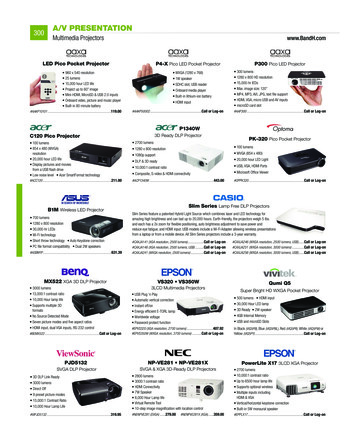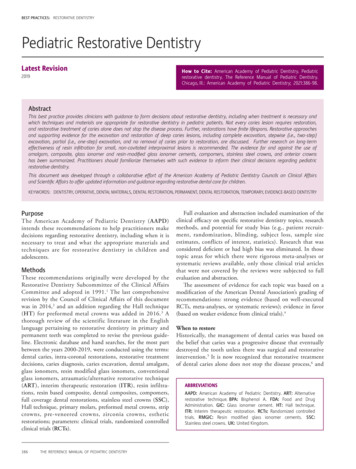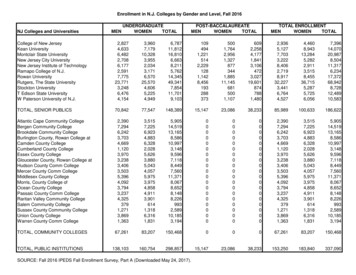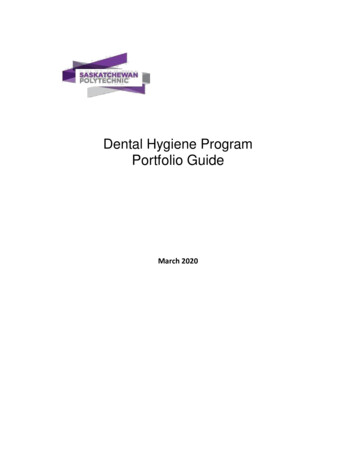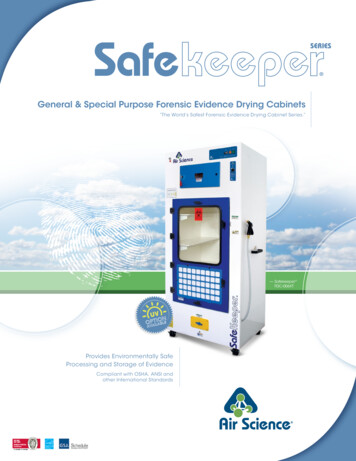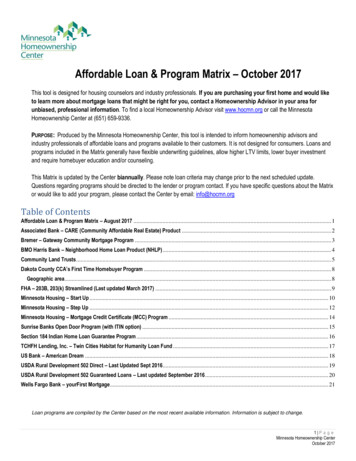
Transcription
BEST PRACTICES:BEHAVIOR GUIDANCEBehavior Guidance for the Pediatric Dental PatientLatest Revision2020How to Cite: American Academy of Pediatric Dentistry. Behaviorguidance for the pediatric dental patient. The Reference Manualof Pediatric Dentistry. Chicago, Ill.: American Academy of PediatricDentistry; 2021:306-24.AbstractThis best practice provides health care personnel, parents, and others with information for predicting and guiding behavior in children duringdental procedures. Successful treatment of pediatric dental patients depends on effective communication and developing customizedbehavior guidance plans dependent on the patient’s treatment needs and the skills of the dentist. Behavior guidance is a continual processfrom basic to advanced techniques, using non-pharmacological and pharmacological options. The following items should be addressedbefore, during, and after patient treatment: informed consent, pain assessment, behavior documentation, and preventive and deferred treatment considering all behavior guidance options. Basic behavior guidance includes communication guidance, positive pre-visit imagery, directobservation, tell-show-do, ask-tell-ask, voice control, non-verbal communication, positive reinforcement and descriptive praise, distraction,and desensitization. For anxious patients and those with special health care needs, additional behavior guidance options include sensoryadapted dental environments, animal assisted therapy, picture exchange communication systems, and nitrous oxide-oxygen inhalation.Advanced behavior guidance includes protective stabilization, sedation, and general anesthesia. Each option should be assessed for objectives,indications, contraindications, and precautions. Knowledge of these options will aid healthcare professionals in providing appropriate patientspecific and family-centered behavior guidance for infants, children, adolescents, and persons with special health care needs.This document was developed through a collaborative effort of the American Academy of Pediatric Dentistry Councils on Clinical Affairsand Scientific Affairs to offer updated information and recommendations to inform health care providers, parents and others about thebehavior guidance techniques used and behavioral influences impacting contemporary pediatric dental care.KEYWORDS: ANESTHESIA, GENERAL, BEHAVIOR THERAPY, CHILD, INFORMED CONSENT, NITROUS OXIDE, PAIN MEASUREMENTPurposeThe American Academy of Pediatric Dentistry (AAPD)recognizes that dental care is medically necessary for the purpose of preventing and eliminating orofacial disease, infection,and pain, restoring the form and function of the dentition,and correcting facial disfiguration or dysfunction.1 Behaviorguidance techniques, both nonpharmalogical and pharmalogical, are used to alleviate anxiety, nurture a positive dentalattitude, and perform quality oral health care safely andefficiently for infants, children, adolescents, and persons withspecial health care needs (SHCN). Selection of techniques mustbe tailored to the needs of the individual patient and the skillsof the practitioner. The AAPD offers these recommendationsto inform health care providers, parents, and other interestedparties about influences on the behavior of pediatric dentalpatients and the many behavior guidance techniques used incontemporary pediatric dentistry. Information regarding painmanagement, protective stabilization, and pharmacologicalbehavior management for pediatric dental patients is providedin greater detail in additional AAPD best practicesdocuments.2-6MethodsRecommendations on behavior guidance were developedby the Clinical Affairs Committe, Behavior ManagementSubcommittee and adopted in 1990.7 This document by theCouncil of Clinical Affairs is a revision of the previous version,306THE REFERENCE MANUAL OF PEDIATRIC DENTISTRYlast revised in 2015.8 The original guidance was developedsubsequent to the AAPD’s 1988 conference on behaviormanagement and modified following the AAPD’s symposiaon behavior guidance in 2003 10 and 2013.11 This updatereflects a review of the most recent proceedings, other dentaland medical literature related to behavior guidance of the pediatric patient, and sources of recognized professional expertiseand stature including both the academic and practicingpediatric dental communities and the standards of the AmericanDental Association Commission on Dental Accreditation.12 Inaddition, a search of the PubMed /MEDLINE electronicdatabase was performed, (see Appendix 1 after References).Articles were screened by viewing titles and abstracts. Data wasabstracted and used to summarize research on behaviorguidance for infants and children through adolescents, including those with special healthcare needs. When data did notappear sufficient or were inconclusive, recommendations werebased upon expert and/or consensus opinion by experiencedresearchers and clinicians. ABBREVIATIONSAAPD: American Academy of Pediatric Dentistry. AAT: Animalassisted therapy. ITR: Interim therapeutic restoration. PECS: Pictureexchange communication system. SADE: Sensory-adapted dentalenvironment. SDF: Silver diamine fluoride. SHCN: Special healthcare needs.
BEST PRACTICES:BackgroundDental practitioners are expected to recognize and effectivelytreat childhood dental diseases that are within the knowledgeand skills acquired during their professional education. Safeand effective treatment of these diseases requires an understanding of and, at times, modifying the child’s and family’sresponse to care. Behavior guidance a continuum of interactioninvolving the dentist and dental team, the patient, and parentdirected toward communication and education, while alsoensuring the safety of both oral health professionals and thechild, during the delivery of medically necessary care. Goalsof behavior guidance are to: 1) establish communication, 2)alleviate the child’s dental fear and anxiety, 3) promote patient’s and parents’ awareness of the need for good oral healthand the process by which it is achieved, 4) promote the child’spositive attitude toward oral health care, 5) build a trustingrelationship between dentist/staff and child/parent, and 6)provide quality oral health care in a comfortable, minimallyrestrictive, safe, and effective manner. Behavior guidance techniques range from establishing or maintaining communicationto stopping unwanted or unsafe behaviors.13 Knowledge ofthe scientific basis of behavior guidance and skills in communication, empathy, tolerance, cultural sensitivity, andflexibility are requisite to proper implementation. Behaviorguidance should never be punishment for misbehavior, powerassertion, or use of any strategy that hurts, shames, or belittlesa patient.Predictors of child behaviorsPatient attributesA dentist who treats children should be able to accuratelyassess the child’s developmental level, dental attitudes, andtemperament to anticipate the child’s reaction to care. Theresponse to the demands of oral health care is complex anddetermined by many factors.Factors that may contribute to noncompliance during thedental appointment include fears, general or situationalanxiety, a previous unpleasant and/or painful dental/medicalexperience, pain, inadequate preparation for the encounter,and parenting practices.13-19 In addition, cognitive age, developmental delay, inadequate coping skills, general behavioralconsiderations, negative emotionality, maladaptive behaviors,physical/mental disability, and acute illness or chronic diseaseare potential reasons for noncompliance during the dentalappointment.13-19Dental behavior management problems often are morereadily recognized than dental fear/anxiety due to associationswith general behavioral considerations (e.g., activity, impulsivity) versus temperamental traits (e.g., shyness, negativeemotionality) respectively. 20 Only a minority of childrenwith uncooperative behavior have dental fears, and not allfearful children present with dental behavior guidance problems.14,21,22 Fears may occur when there is a perceived lack ofcontrol or potential for pain, especially when a child is awareof a dental problem or has had a painful healthcare experience.BEHAVIOR GUIDANCEIf the level of fear is incongruent with the circumstances andthe patient is not able to control impulses, disruptive behavioris likely.20Cultural and linguistic factors also may play a role in patientcooperation and selection of behavior guidance techniques.23-26Since every culture has its own beliefs, values, and practices,it is important to understand how to interact with patientsfrom different cultures and to develop tools to help navigatetheir encounters. Translation services should be made availablefor those families who have limited English proficiency. 26,27A federal mandate requires translation services for non-Englishspeaking families be available at no cost to the family inhealthcare facilities that receive federal funding for services.28As is true for all patients/families, the dentist/staff must listenactively and address the patient’s/parents’ concerns in a sensitiveand respectful manner.23Parental influencesParents influence their child’s behavior at the dental office inseveral ways. Positive attitudes toward oral health care maylead to the early establishment of a dental home. Early preventive care leads to less dental disease, decreased treatmentneeds, and fewer opportunities for negative experiences.29,30Parents who have had negative dental experiences as a patientmay transmit their own dental anxiety or fear to the childthereby adversely affecting her attitude and response tocare. 14,17,31,32 Long term economic hardship leads to stress,which can lead to parental adjustment problems such as depression, anxiety, irritability, substance abuse, and violence.23Parental depression may result in parenting changes, includingdecreased supervision, caregiving, and discipline for the child,thereby placing the child at risk for a wide variety of adjustment issues including emotional and behavior problems.23 InAmerica, evolving parenting styles17,18 and parental behaviorsinfluenced by economic hardship have left practitionerschallenged by an increasing number of children ill-equippedwith the coping skills and self-discipline necessary to contendwith new experiences.23,24,26 Frequently, parental expectationsfor the child’s response to care (e.g., no tears) are unrealistic,while expectations for the dentist who guides their behaviorare great.19Orientation to dental environmentThe non-clinical office staff plays an important role inbehavior guidance. The scheduling coordinator or receptionistoften will be the first point of contact with a prospectivepatient and family, either through the internet or a telephoneconversation. The tone of the communication should be welcoming. The scheduling coordinator or receptionist shouldactively engage the patient and family to determine theirprimary concerns, chief complaint, and any special health careor cultural/linguistic needs. The communication can provideinsights into patient or family anxiety or stress. Staff shouldhelp set expectations for the initial visit by providing relevantinformation and may suggest a pre-appointment visit to theTHE REFERENCE MANUAL OF PEDIATRIC DENTISTRY307
BEST PRACTICES:BEHAVIOR GUIDANCEoffice to meet the doctor and staff and tour the facility.20 Thenon-clinical staff should confirm the office’s location, offerdirections, and ask if there are any further questions. Suchencounters serve as educational tools that help to allay fearsand better prepare the family and patient for the first visit.The parent’s/patient’s initial contact with the dental practiceallows both parties to address the child’s primary oral healthneeds and to confirm the appropriateness of scheduling anappointment.33 From a behavioral standpoint, many factorsare important when appointment times are determined. 20Appointment-related concerns include patient age, presenceof a special health care need, the need for sedation, distancethe parent/patient travels, length of appointment, additionalstaffing requirements, parent’s work schedule, and time of day.Emergent or urgent treatment should not be delayed on thesegrounds alone.34 Appointment scheduling should be tailoredto the needs of the individual patient’s circumstances and theskills of the practitioner. The practitioner should formulatea policy regarding scheduling, and scheduling should notbe left to chance. 20 Appointment duration should not beprolonged beyond a patient’s tolerance level solely for thepractitioner’s convenience. 20 Consideration of appointmentscheduling will benefit the parent/patient and practitioner bybuilding a trusting relationship that promotes the patient’spositive attitude toward oral health care.Reception staff are usually the first team members thepatient meets upon arrival at the office. The caring and assuringmanner in which the child is welcomed into the practiceat the first and subsequent visits is important.19,35 A childfriendly reception area (e.g., age-appropriate toys and games)can provide a distraction for and comfort young patients.These first impressions may influence future behaviors.Patient assessmentAn evaluation of the child’s cooperative potential is essentialfor treatment planning. No single assessment method or toolis completely accurate in predicting a patient’s behavior, butawareness of the multiple influences on a child’s response tocare can aid in treatment planning.36 Initially, information canbe gathered from the parent through questions regarding thechild’s cognitive level, temperament/personality characteristics,15,22,37,38,39 anxiety and fear,14,22,40 reaction to strangers,41and behavior at previous medical/dental visits, as well as howthe parent anticipates the child will respond to future dentaltreatment. Later, the dentist can evaluate cooperative potentialby observation of and interaction with the patient. Whetherthe child is approachable, somewhat shy, or definitely shyand/or withdrawn may influence the success of various communicative techniques. Assessing the child’s development,past experiences, and current emotional state allows thedentist to develop a behavior guidance plan to accomplish thenecessary oral health care.20 During delivery of care, the dentistmust remain attentive to physical and/or emotional indicatorsof stress.23-26,42 Changes in behaviors may require alterationsto the behavioral treatment plan.308THE REFERENCE MANUAL OF PEDIATRIC DENTISTRYDentist/dental team behaviorsThe behaviors of the dentist and dental staff members are theprimary tools used to guide the behavior of the pediatricpatient. The dentist’s attitude, body language, and communication skills are critical to creating a positive dental visit forthe child and to gain trust from the child and parent.29 Dentistand staff behaviors that can help reduce anxiety and encouragepatient cooperation include giving clear and specific instructions, having empathetic communication style, and offeringverbal reassurance.43 Dentists and staff must continue to beattentive to their communication styles throughout interactionswith patients and families.44Communication (i.e., imparting or interchange of thoughts,opinions, or information) may occur by a number of meansbut, in the dental setting, it is accomplished primarily throughdialogue, tone of voice, facial expression, and body language.45Communication between the doctor/staff and the child andparent is vital to successful outcomes in the dental office.The four essential ingredients of communication are:1. the sender,2. the message, including the facial expression and bodylanguage of the sender,3. the context or setting in which the message is sent, and4. the receiver.46For successful bi-directional communication to take place,all four elements must be present and consistent. Withoutconsistency, there may be a poor fit between the intendedmessage and what is understood.45Communicating with children poses special challengesfor the dentist and the dental team. A child’s cognitivedevelopment will dictate the level and amount of informationinterchange that can take place.26 With a basic understandingof the cognitive development of children, the dentist can useappropriate vocabulary and body language to send messagesconsistent with the receiver’s intellectual development.26,45Communication may be impaired when the sender’s expression and body language are not consistent with the intendedmessage. When body language conveys uncertainty, anxiety,or urgency, the dentist cannot effectively communicate confidence or a calm demeanor.45In addition, the operatory may contain distractions (e.g.,another child crying) that, for the patient, produce anxietyand interfere with communication. Dentists and other members of the dental team may find it advantageous to discusscertain information (e.g., post-operative instructions,preventive counseling) away from the operatory and its manydistractions.19The communicative behavior of dentists is a major factorin patient satisfaction.46,47 Dentist actions that are reported tocorrelate with low parent satisfaction include rushing throughappointments, not taking time to explain procedures, barringparents from the examination room, and generally beingimpatient.37,43 However, when a provider offers compassion,empathy, and genuine concern, there may be better acceptance
BEST PRACTICES:of care.43 While some patients may express a preference for aprovider of a specific gender, female and male practitionershave been found to treat patients and parents in a similarmanner.39The clinical staff is an extension of the dentist in behaviorguidance. A collaborative approach helps assure that both thepatient and parent have a positive dental experience. All dental team members are encouraged to expand their skills andknowledge through dental literature, video presentations, and/or continuing education courses.49Informed consentAll behavior guidance decisions must be based on a review ofthe patient’s medical, dental, and social history followed by anevaluation of current behavior. Decisions regarding the useof behavior guidance techniques other than communicativemanagement cannot be made solely by the dentist. They mustinvolve a parent and, if appropriate, the child. The practitioner,as the expert on dental care (i.e., the timing and techniquesby which treatment can be delivered), should effectively communicate behavior and treatment options, including potentialbenefits and risks, and help the parent decide what is in thechild’s best interests. 29 Successful completion of diagnosticand therapeutic services is viewed as a partnership of dentist,parent, and child.29,50,51 The conversation should allow questionsfrom the parent and patient in order to clarify issues and toverify the parents’ and child’s comprehension. This should bedone in the family’s preferred language, with assistance of atrained interpreter if needed.13,28Communicative management, by virtue of being a basicelement of communication, requires no specific consent. Allother behavior guidance techniques require informed consent consistent with the AAPD’s Best Practices on InformedConsent52 and applicable state laws. A signature on the consent form does not necessarily constitute informed consent.Informed consent implies information was provided to theparent, risks/benefits and alternatives were discussed, questionswere answered, and permission was obtained prior to administration of treatment.13 If the parent refuses treatment afterdiscussions of the risks/benefits and alternatives of the proposedtreatment and behavior guidance techniques, an informedrefusal form should be signed by the parent and retained inthe patient’s record.53 If the dentist believes the informed refusal violates proper standard of care, he should recommendthe patient seek another opinion and/or dismiss the patientfrom the practice.52 If the dentist suspects dental neglect54, heis obligated to report to appropriate authorities.52,55In the event of an unanticipated behavioral reaction todental treatment, it is incumbent upon the practitioner to protect the patient and staff from harm. Following immediateintervention to assure safety, if a new behavior guidance plan isdeveloped to complete care, the dentist must obtain informedconsent for the alternative methods.52,56,57BEHAVIOR GUIDANCEPain assessment and management during treatmentPain has a direct influence on behavior and should be assessedand managed throughout treatment.58 Anxiety may be a predictor of increased pain perception.59 Findings of pain or apainful past health care visit are important considerations inthe patient’s medical/dental history that will help the dentistanticipate possible behavior problems. 2,53,58 Prevention orreduction of pain during treatment can nurture the relationship between the dentist and the patient, build trust, allay fearand anxiety, and enhance positive dental attitudes for futurevisits.60-64 Pain can be assessed using self-report, behavioral, andbiological measures. In addition, there are several pain assessment instruments that can be used in patients.2 The subjectivenature of pain perception, varying patient responses to painfulstimuli, and lack of use of accurate pain assessment scales mayhinder the dentist’s attempts to diagnose and intervene duringprocedures.31,61,62,65-67 Observing changes in patient behavior(e.g., facial expressions, crying, complaining, body movementduring treatment) as well as biologic measures (e.g., heartrate, sweating) is important in pain evaluation. 2,61,64 Thepatient is the best reporter of her pain. 31,62,65,66 Listening tothe child at the first sign of distress will facilitate assessmentand any needed procedural modifications.62 At times, dentalproviders may underestimate a patient’s level of pain or maydevelop pain blindness as a defense mechanism and continueto treat a child who really is in pain.31,61,68-71 Misinterpreted orignored changes in behavior due to painful stimuli can causesensitization for future appointments as well as psychologicaltrauma.72Documentation of patient hehaviorsRecording the child’s behavior serves as an aid for futureappointments.66 One of the more reliable and frequently usedbehavior rating systems in both clinical dentistry and researchis the Frankl Scale.20,66,73 This scale (see Appendix 2) separatesobserved behaviors into four categories ranging from definitelynegative to definitely positive.20,66,73 In addition to the ratingscale, an accompanying descriptor (e.g., “ , non-verbal”) willhelp practitioners better plan for subsequent visits.Treatment deferralDental disease usually is not life-threatening, and the type andtiming of dental treatment can be deferred in certain circumstances. When a child’s cognitive abilities or behavior preventsroutine delivery of oral health care using communicativeguidance techniques, the dentist must consider the urgency ofdental need when determining a plan of treatment.56,57 In somecases, treatment deferral may be considered as an alternativeto treating the patient under sedation or general anesthesia.However, rapidly advancing disease, trauma, pain, or infectionusually dictates prompt treatment. Deferring some or all treatment or employing therapeutic interventions (e.g., silverdiamine fluoride [SDF] 74 interim therapeutic restoration[ITR],75,76 fluoride varnish, antibiotics for infection control)until the child is able to cooperate may be appropriate whenTHE REFERENCE MANUAL OF PEDIATRIC DENTISTRY309
BEST PRACTICES:BEHAVIOR GUIDANCEbased upon an individualized assessment of the risks andbenefits of that option. The dentist must explain the risks andbenefits of deferred or alternative treatments clearly, andinformed consent must be obtained from the parent.52,53,56 Inselect cases where ITR or SDF is employed, regular reevaluations are recommended and retreatment may be needed.77,78Treatment deferral also should be considered in cases whentreatment is in progress and the patient’s behavior becomeshysterical or uncontrollable. In such cases, the dentist shouldhalt the procedure as soon as possible, discuss the situationwith the patient/parent, and either select another approachfor treatment or defer treatment based upon the dental needsof the patient. If the decision is made to defer treatment, thepractitioner immediately should complete the necessary stepsto bring the procedure to a safe conclusion before ending theappointment.57,75,76Caries risk should be reevaluated when treatment optionsare compromised due to child behavior.79 An individualizedpreventive program, including appropriate parent educationand a dental recall schedule, should be recommended afterevaluation of the patient’s caries risk, oral health needs, andabilities. Topical fluorides (e.g., brush-on gels, fluoridevarnish, professional application during prophylaxis) maybe indicated. 80 ITR may be useful as both preventive andtherapeutic approaches.75,76Behavior guidance techniquesSince children exhibit a broad range of physical, intellectual,emotional, and social development and a diversity of attitudesand temperament, it is important that dentists have a widerange of behavior guidance techniques to meet the needs ofthe individual child and be tolerant and flexible in theirimplementation.18,25 Behavior guidance is not an applicationof individual techniques created to deal with children, butrather a comprehensive, continuous method meant to developand nurture the relationship between the patient and doctor,which ultimately builds trust and allays fear and anxiety. Someof the behavior guidance techniques in this document are intended to maintain communication, while others are intendedto extinguish inappropriate behavior and establish communication. As such, these techniques cannot be evaluated on anindividual basis as to validity but must be assessed within thecontext of the child’s total dental experience. Techniques mustbe integrated into an overall behavior guidance approachindividualized for each child. Consequently, behavior guidanceis as much an art as it is a science.RecommendationsBasic behavior guidanceCommunication and communicative guidanceCommunicative management and appropriate use of commandsare applied universally in pediatric dentistry with both thecooperative and uncooperative child. At the beginning ofa dental appointment, asking questions and active/reflectivelistening can help establish rapport and trust.81,82 The dentist310THE REFERENCE MANUAL OF PEDIATRIC DENTISTRYmay establish teacher/student roles in order to develop aneducated patient and deliver quality dental treatment safely.20,29Once a procedure begins, bi-directional communicationshould be maintained, and the dentist should consider thechild as an active participant in his well-being and care.83With this two-way interchange of information, the dentist alsocan provide one-way guidance of behavior through directives.Use of self-disclosing assertiveness techniques (e.g., “I needyou to open your mouth so I can check your teeth”, “I needyou to sit still so we can take an X-ray”) tells the child exactlywhat is required to be cooperative.82 The dentist can ask thechild ‘yes’ or ‘no’ questions where the child can answer witha ‘thumbs up’ or ‘thumbs down’ response. Also, observationof the child’s body language is necessary to confirm themessage is received and to assess comfort and pain level.60,61,82Communicative guidance comprises a host of specific techniques that, when integrated, enhance the evolution of acooperative patient. Rather than being a collection of singulartechniques, communicative guidance is an ongoing subjectiveprocess that becomes an extension of the personality of thedentist. Associated with this process are the specific techniquesof pre-visit imagery, direct observation, tell-show-do,ask-tell-ask, voice control, nonverbal communication, positivereinforcement, various distraction techniques (e.g., audio,visual, imagination, thoughtful designs of clinic), memoryrestructuring desensitization to dental setting and procedures,parental presence/absence, enhanced control, additionalconsiderations for patients with anxiety or SHCN and nitrousoxide/oxygen inhalation. 81 The dentist should consider thedevelopment of the patient, as well as the presence of othercommunication deficits (e.g., hearing disorder), when choosingspecific communicative guidance techniques.Positive pre-visit imagery Description: Patients preview positive photographs orimages of dentistry and dental treatment before the dentalappointment.84 Objectives: The objectives of positive pre-visit imagery areto:— provide children and parents with visual informationon what to expect during the dental visit; and— provide children with context to be able to ask providersrelevant questions before dental procedures commence. Indications: Use with any patient. Contraindication: None.Direct observation Description: Patients are shown a video or are permittedto directly observe a young cooperative patient undergoingdental treatment.85,86 Objectives: The objectives of direct observation are to:— familiarize the patient with the dental setting andspecific steps involved in a dental procedure; and
BEST PRACTICES:— provide an opportunity for the patient and parent toask questions about the dental procedure in a safeenvironment. Indications: Use with any patient. Contraindications: None.Tell-show-do Description: The technique involves verbal explanations ofprocedures in phrases appropriate to the developmentallevel of the patient (tell); demonstrations for the patient ofthe visual, auditory, olfactory, and tactile aspects of theprocedure in a carefully defined, nonthreatening setting(show); and then, without deviating from the explanationand demonstration, completion of the procedure (do). Thetell-show-do technique operates with c
306 THE REFERENCE MANUAL OF PEDIATRIC DENTISTRY 306 THERF NF06C PPPurposeMtPhdeAoD:rP Purpose The American Academy of . reflects a review of the most recent proceedings, other dental and correcting facial disfiguration or dysfunction.1 Behavior and medical literature related to behavior guidance of the pedi-guidance techniques, both .
